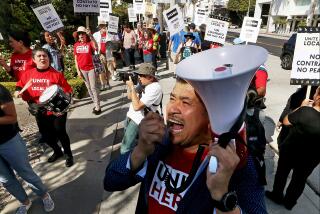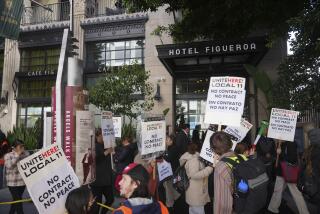Santa Monica’s Workers Deserve a Living Wage
How much will Big Business spend to avoid paying workers a decent wage?
That’s the question in Santa Monica, where powerful special interests have amassed a seemingly limitless war chest in their attempt to defeat a popular living-wage campaign that has attracted national attention.
A business group, led by luxury beach hotels, is expected to launch an expensive signature-gathering drive to repeal Santa Monica’s new living wage law. The hotels and their allies are pressing ahead with the drive to repeal a new city wage law. And if that falls short, they have threatened lawsuits against the city. Hanging in the balance is the future of about 2,000 housekeepers, janitors, dishwashers and other low-wage tourism employees.
These are the men and women who provide the labor for Santa Monica’s booming coastal zone, an area of nearly unrivaled affluence that conceals an underclass of impoverished workers.
Over the past 15 years, $180 million in taxpayer funds has transformed the city’s once-sleepy coastal zone into a tourism mecca filled with luxury beach hotels, high-end restaurants and national chain retail outlets. These businesses have succeeded wildly, riding the wave of Santa Monica’s publicly funded revitalization. Beach hotels saw their revenues more than double from 1993 to 1999, and tourism industry revenues jumped from $200 million to $700 million over a 15-year period.
Left behind in all this prosperity are the workers. A study conducted by the city last year found that the most low-wage workers in the coastal zone were living in conditions of poverty or near poverty.
Pay was so low that the family of the average low-wage coastal zone worker was eligible for more than $8,000 a year in anti-poverty government assistance. This means that many full-time workers wereforced to rely on food stamps, public health insurance and other benefits.
Under the city’s new living wage law, employees at Santa Monica’s largest, most successful businesses will receive $10.50 an hour--the wage at which a worker supporting a family of four no longer qualifies for food stamps. Those without employer-provided medical benefits will get an extra $1.75 an hour so they can buy health insurance for their families.
Hoping to terrify voters into signing the repeal petition, business interests are claiming that the living-wage law will lead to economic Armageddon.
Nothing could be further from the truth.
The living-wage ordinance is a targeted, carefully crafted piece of legislation that will only affect an estimated 40 companies--less than 1% of the city’s 10,000 businesses.
Those covered by the law are large, successful businesses--many owned by national or multinational corporations--that can well afford to pay their workers more than poverty wages, according to the city’s economic impact study.
These businesses are not only out of step with Santa Monica voters, they are behind the national curve when it comes to the working poor. More than 60 municipalities throughout the country have passed living-wage laws, reflecting a deep unease on the part of the American public over the human cost of poverty-level jobs.
Not only are living-wage laws popular, but they help workers without hurting the economy. That’s the conclusion reached recently by Business Week, which ran a story lauding the benefits of living-wage legislation. This view is shared by many labor economists on both sides of the political divide.
Santa Monica’s powerful business interests, however, regard these facts with disdain.
The people have decided in favor of low-wage workers. It’s time that Big Business gets the message. Santa Monica voters can make sure they do by declining to sign the petition to repeal the living wage.
More to Read
Inside the business of entertainment
The Wide Shot brings you news, analysis and insights on everything from streaming wars to production — and what it all means for the future.
You may occasionally receive promotional content from the Los Angeles Times.










